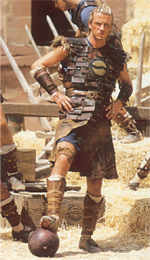Tapping into male trends |
 |
| Men have finally discovered shopping and as a new book about marketing to men reveals they are becoming serious consumers. John Fanning gives his verdict on Branded Male |
Professor
Henry Higgins in My Fair Lady
famously declared “why can't a woman be more like a man?”. Nowadays, men are
being told to become more like women as we hear of terms like ‘metrosexual'. Prof
Anthony Clare, probably Ireland's
best known psychiatrist, who died last year, published a book in 2000 titled
‘Masculinity in Crisis'.
Clare's
book was a highly topical millennium issue caused by a combination of the
decline in many traditional male bastions, following the increasing presence of
women in the workforce. Even science had made the male biologically redundant.
Men, said Clare, would have to evolve from their aggressive position of
dominant emotional cripples and get in touch with their feminine side and a
surprising number of them could not wait.
Well at
least David Beckham! Years ago, men were
defined by the trades they pursued; Smith, Taylor, Miller, Farmer, Archer,
Thatcher, but with the demise of the traditional crafts no one wanted to be
lumbered with a double barreler like ‘Financial-Services'. Now that self-identity is no longer stable and
securely guaranteed by one's occupation we are seeing attempts to derive
identity from the body which explains the rise of ‘body culture'. It is not
just the dubious tattoos but results from a recent survey showed that some men were being criticised for, wait for it; ‘letting
themselves go'.
Whether
you're alarmed or enthused by these developments, they undoubtedly represent
opportunities for marketing across a range of product fields and a new book by
Mark Tungate, Branded Male (Kogan
Page) offers a useful introduction to the subject.
Tungate is
a journalist specialising in marketing communications and we've reviewed two of
his books here in recent times – Fashion
Brands and Adland. Now he tackles
the branded male and the book's 14 chapters take the reader on a whistle-stop
tour of all the usual male consumption suspects; clothes, wheels, travel,
gadgets, sex, alcohol, restaurants, hotels, pictures (TV and videos) and words
(lads mags). But it also covers some of the less usual ones; home, body, diet
and skin.
The chapter
on ‘cloth' makes the valid point that male ostentation in dress is not exactly
a recent phenomenon. Beau Brummell was born in the 18th century and
he was regarded as the ultimate dandy; “noble, muscular, self-evidently
aspirational, utterly uneffeminate'!” “The casual clothes of the day consisted
of Hessian riding boots, riding breeches and cutaway riding jackets so that
even West End ‘loungers' who had no intention of riding anywhere could give the
appearance of readiness to mount a horse and gallop towards revolution,”
Tungate explained. Just like today's south Dubliners driving their kids to
school in vehicles that would enjoy a reasonable level of safety in a Baghdad battle.
 |
METRO MANDavid Beckham is the world's best known branded male. The former England captain has earned a reputation as a metrosexual. Branded Male tries to shed new light on which marketing messages have a real impact on men's wallets. In 1990, only four per cent of men used a skincare product. By 2015, the figure will have risen to one in two men. |
One of the
main reasons why so many product categories that used to be the exclusive
preserve of women and are now setting their sights on men is the increasingly
late marriage age. With more men as well as women living on their own in their
twenties and well into thirties they are taking much more interest in d









